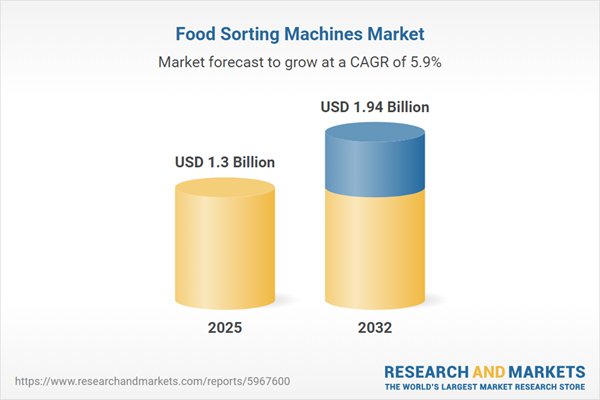Speak directly to the analyst to clarify any post sales queries you may have.
Food sorting machines are reshaping the global food processing landscape, providing manufacturers with powerful, automated tools to enhance safety standards, optimize workflows, and ensure unmatched product consistency. For executive decision-makers, these solutions are vital for operational excellence amid tightening regulations and rising consumer expectations.
Market Snapshot: Food Sorting Machines Market Growth and Outlook
The Food Sorting Machines Market grew from USD 1.23 billion in 2024 to USD 1.30 billion in 2025. Projected to advance at a CAGR of 5.85%, the market will reach USD 1.94 billion by 2032. Demand is fueled by global regulatory changes, expanding food safety initiatives, and the evolution of next-generation automation and digital monitoring capabilities. These drivers are pushing stakeholders to upgrade equipment and adopt flexible sorting technologies that align with dynamic production needs and sustainability mandates.
Scope & Segmentation: Overview of Key Segments and Technologies
- Technology: Infrared Sorting, Magnetic Sorting, Metal Detection, Optical Sorting (Color, Defect, Shape Sorting), X-Ray Sorting (Multi-Energy, Single-Energy)
- Product Type: Bakery & Confectionery, Dairy, Fruits & Vegetables (Dried, Fresh, Frozen), Grains & Nuts, Meat, Seafood
- End User: Bakeries, Dairy Plants, Food Processors, Meat Processors, Seafood Processors
- Automation Level: Fully Automatic, Semi-Automatic, Manual
- Region: Americas (United States, Canada, Mexico, Brazil, Argentina, Chile, Colombia, Peru), Europe, Middle East & Africa (United Kingdom, Germany, France, Russia, Italy, Spain, Netherlands, Sweden, Poland, Switzerland, UAE, Saudi Arabia, Qatar, Turkey, Israel, South Africa, Nigeria, Egypt, Kenya), Asia-Pacific (China, India, Japan, Australia, South Korea, Indonesia, Thailand, Malaysia, Singapore, Taiwan)
- Major Companies: TOMRA Systems ASA, Bühler AG, Key Technology LLC, Mettler-Toledo International Inc., Satake Corporation, AWETA B.V., Bizerba GmbH & Co. KG, Anritsu Engineering Inc., GREEFA B.V., Luxcel Technology Co., Ltd.
Key Takeaways for Decision-Makers
- The integration of artificial intelligence and machine learning in food sorting solutions is enabling real-time, precise quality assessment and rapid adaptation to production changes.
- Automation and digitalization are transforming traditional sorting lines, supporting predictive maintenance and remote operation for improved uptime and cost efficiency.
- New product development increasingly focuses on modular system designs and energy-efficient architectures that support fast changeovers and minimize waste.
- Regional market variations call for tailored automation solutions—Americas and Europe are seeing robust regulatory-driven innovation, while Asia-Pacific leverages rapid facility expansion and technology adoption.
- Strategic alliances among equipment vendors, software firms, and academic institutions are accelerating the deployment of advanced features such as hyperspectral analysis and cloud-based analytics.
Tariff Impact: United States Tariffs and Supply Chain Shifts
Recent tariffs in the United States have influenced sourcing strategies, increasing landed costs for advanced food sorting technologies. Companies are mitigating tariff exposure by diversifying suppliers, utilizing nearshore assembly, and strengthening local research and after-sales support. These shifts emphasize the importance of supply chain agility and localized innovation for maintaining competitiveness in North American and global markets.
Methodology & Data Sources
This report is grounded in primary interviews with senior executives, engineers, and procurement specialists, paired with secondary analysis of industry publications, patents, and regulatory documents. Quantitative insights are further validated by supply chain mapping, case studies, and peer reviews to ensure consistency, reliability, and accuracy across all device and trend analyses.
Why This Report Matters
- Enables informed investment and procurement decisions for senior executives facing shifting regulatory and technology landscapes in the food sorting machines market.
- Provides up-to-date intelligence on emerging automation, digitalization, and modular design trends relevant to operational expansion or optimization.
- Supports risk mitigation strategies with in-depth, region-specific insight on tariffs, supply chain movements, and competitive positioning.
Conclusion
Advanced food sorting machines deliver measurable improvements in efficiency, safety, and regulatory compliance. With an expanding range of digital and automated capabilities, industry leaders are positioned to meet evolving demands and seize opportunities in complex, fast-moving markets.
Additional Product Information:
- Purchase of this report includes 1 year online access with quarterly updates.
- This report can be updated on request. Please contact our Customer Experience team using the Ask a Question widget on our website.
Table of Contents
3. Executive Summary
4. Market Overview
7. Cumulative Impact of Artificial Intelligence 2025
Companies Mentioned
The companies profiled in this Food Sorting Machines market report include:- TOMRA Systems ASA
- Bühler AG
- Key Technology, LLC
- Mettler-Toledo International Inc.
- Satake Corporation
- AWETA B.V.
- Bizerba GmbH & Co. KG
- Anritsu Engineering, Inc.
- GREEFA B.V.
- Luxcel Technology Co., Ltd.
Table Information
| Report Attribute | Details |
|---|---|
| No. of Pages | 189 |
| Published | October 2025 |
| Forecast Period | 2025 - 2032 |
| Estimated Market Value ( USD | $ 1.3 Billion |
| Forecasted Market Value ( USD | $ 1.94 Billion |
| Compound Annual Growth Rate | 5.8% |
| Regions Covered | Global |
| No. of Companies Mentioned | 11 |









